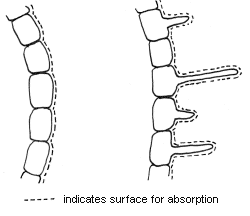In most plants, the roots are responsible for taking in water
from the surrounding soil, along with the dissolved nutrients that water contains. These
nutrients are not exactly "food" for the plants; rather, they are substances the
plant needs to stay healthy so it can manufacture its own food, or sugars, by a process
called photosynthesis. (We’ll tackle that in the next section.)As with the anchoring function, plants have adapted different
approaches for finding the water and nutrients they need.
Surface roots intercept water as it filters down through
the soil, capturing the nutrients the water has picked up as it travels through the soil.
Taproots, on the other hand, head deep into the soil to
search for nutrients. Farmers and gardeners can use cover crops of tap-rooted plants to
"mine" nutrients from deep in the soil. As the taproots take up these nutrients,
they distribute them throughout the plant body. When the mature plants are tilled into the
soil, the nutrients they contain are incorporated into the topsoil—the region where
most crop plants’ roots are concentrated.
Both fibrous roots and taproots have root hairs. These are
very fine, hair-like projections that occur in great numbers just behind the tip of
growing roots. Roots take in water and nutrients by absorbing them through their surface
cells. The presence of root hairs vastly increases the surface area available for this
absorption.
Tip of growing root

Root epidermal cells, enlarged.

Note how the presence of root hairs increases the area available for absorption.